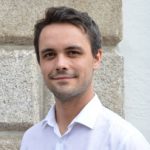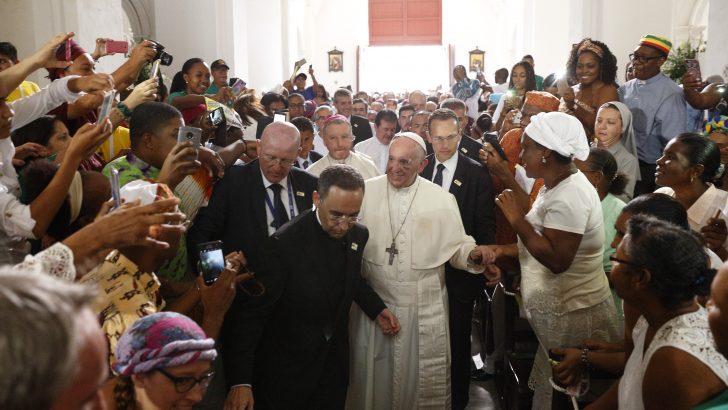The Pope in Ireland
Chai Brady discusses the Pope’s trips abroad and their importance
Although Pope Francis has travelled many times within Italy, it is his foreign trips that have drawn the most interest – and sometimes controversy.
He is the first Pope to enter a warzone, is not afraid to tackle delicate political issues and has held countries to account for their failings regarding the environment, migrants, poverty and more.
However, the Pope didn’t immediately begin travelling extensively until a year after he was elected. Brazil was the only foreign country he visited in 2013, with his Mass on Copacabana beach attracting three million people.
The festive crowd included pilgrims from 170 nations who spent the night on the beach and locals who poured out of homes and buses to see the Argentine Pope on his first trip abroad since his election in March.
“Through your joyful witness and service, help to build a civilisation of love. Show, by your life, that it is worth giving your time and talents to attain high ideals,” Francis said at the Rio airport before he departed for Rome.
In 2014 Francis became much more active abroad, managing trips to Israel, Jordan and Palestine in May. He immediately tackled the difficult political tensions and conflict that has continued to this day between Israel and Palestine saying: “The time has come to put an end to this situation, which has become increasingly unacceptable.”
He said both sides needed to make sacrifices to create two states with internationally recognised borders, based on mutual security and rights for everyone.
Experiences
For five days Francis visited South Korea for the Sixth Asian Youth Day, which brought together some 2,000 young people from 16 Korean dioceses who shared and exchanged their life experiences, and recommitted and reconfirmed their Faith.
This was followed by a trip to Albania, the first European trip made by Francis. Despite Iraqi government officials warning there may be an attempt on his life by Islamic fundamentalists, the Pope went ahead with his 11-hour visit.
Reflecting the importance he places in ecumenism and the “existential peripheries” of the Church, he said he wanted to go to Albania because it represented a “government of national unity” which comprised Muslims, Eastern Orthodox and Catholics. Only 10% of Albania’s population are Catholic.
He spent four hours in France a month later, the shortest visit made by any Pope abroad where he addressed the European Parliament raising issues related to the dignity of migrants and conditions for workers.
This was followed a few days later by a trip to Turkey after being invited by the president and Patriarch Bartholomew I of the Eastern Orthodox Church.
Opportunity
Kicking-off 2015 he visited Sri Lanka, and became the fourth Pope to go to the Philippines, a trip that will go down in history as the largest papal event the world has ever seen. His Mass in Manila attracted 6-7 million people.
This was followed by a visit to Bosnia and Herzegovina in June, which he used as another opportunity to promote ecumenism and dialogue between churches.
His focus on the Church’s peripheries, relating to indigenous people and the environment was reflected in his trips to Bolivia, Ecuador and Paraguay in South America in July of that year.
Departing on Shepherd One [the papal plane] in September, Francis went to Cuba and the US, which was followed by a trip to Africa.
While in Kenya, Uganda and the Central African Republic (CAR) he spoke of the need to protect the environment, address poverty and inequality and called for peace and interreligious dialogue to stop religious conflict.
Francis took the biggest risk of any Pope by being the first to enter an active warzone in CAR, where he visited a mosque being besieged by Christian militants. He called for peace, saying, “Christians and Muslims are brothers and sisters”.
At the beginning of 2016 he stopped in Cuba to sign a declaration with the Russian Orthodox Church to address global issues and solidify their hope to re-establish full unity.
He then went on to Mexico after an invitation from their president.
In April he departed to the Greek island of Lesbos in support of thousands of migrants, many from Syria, seeking asylum status, and in June went to Armenia.
Francis attended World Youth Day 2016 in Poland, a country with the highest percentage of young people registered as Catholic in Europe. He spent time in prayer at Auschwitz concentration ca- mp and met Holocaust survivors.
In September that year he went to Georgia and spoke of ecumenism with the Georgian Orthodox, and then visited the mainly Muslim Azerbaijan, where he steered clear of criticising the increasingly authoritarian presidency of Ilham Aliyev and spoke of dialogue and tolerance.
This was followed by a one-day visit to Sweden the following month.
Francis went to Egypt in April, a country that has seen a huge amount of violence against Christians, to deliver a message of peace.
He then departed to Fatima in Portugal in May and then on to Colombia for a five-day visit in September. While there he promoted the Colombian peace process between insurgent group FARC [who ceased to be an armed group in 2017] and the current government.
He then visited Myanmar and Bangladesh at a time when the Myanmar government was accused of ethnic cleansing, as a minority Muslim group called the Rohingya people were forced from their land by the Myanmar army. Many fled over the border to Bangladesh to seek asylum in Cox’s Bazaar.
2018 began with a visit to both Chile and Peru in January followed by Switzerland in June.
And in just a few days Francis will make an historic trip to Ireland, the second time a Pontiff has ever stepped foot in the country since St John Paul II in 1979 from August 25-26. Expectations are high for the visit, which will most certainly go down in history.


 Chai Brady
Chai Brady Pope Francis greets people as he arrives to visit the Shrine of St. Peter Claver in Cartagena, Colombia
Pope Francis greets people as he arrives to visit the Shrine of St. Peter Claver in Cartagena, Colombia 